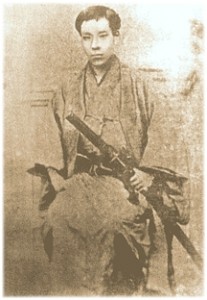
During the first two months of 1866, around two years before the fall of the Tokugawa Bakufu, the anti-Bakufu rebels in Chōshū, led by the indomitable young samurai Takasugi Shinsaku, ousted the ruling conservatives in a bloody civil war. As leader of Chōshū’s powerful army, Takasugi envisaged Chōshū as becoming “the most powerful and wealthy nation among the five great continents.”
Chōshū (modern-day Yamaguchi Prefecture) was one of two samurai clans most responsible for overthrowing the Bakufu and bringing about the Meiji Restoration. The other was its rival Satsuma (modern-day Kagoshima Prefecture). After the United States, Great Britain, France and others forced unfair trade treaties on the thus far isolated country in 1858, samurai from Chōshū, Satsuma, and other parts of Japan, most notably Tosa (modern-day Kochi Prefecture and home domain of Sakamoto Ryōma), called for a “strong military and rich nation” under a newly restored monarchy to fend off Western imperialism. They developed a military strong enough to overthrow the Tokugawa Bakufu, which, under the shogun, had ruled the country for over two and a half centuries.
For Takasugi “the five great continents” were synonymous with “the world,” suggesting his belief that Japan’s future lay with Chōshū. And to a great extent he was right. Former samurai of Chōshū and Satsuma would control the Meiji government into the twentieth century. During its infancy, the new Meiji government was dominated by the triad of Saigō Takamori, Ōkubo Toshimichi, and Kido Takayoshi (formerly Katsura Kogorō), and the Court nobles Sanjō Sanétomi and Iwakura Tomomi. After the deaths of Saigō, Ōkubo, and Kido within one year of each other (Kido of illness in May 1877, Saigō on the battlefield that September, Ōkubo by assassination in May 1878), the Japanese government continued to be dominated by Satsuma and Chōshū men, including Itō Hirobumi, Inoué Kaoru and Yamagata Aritomo. Itō, architect of the Meiji Constitution of 1889, was the Meiji government’s first prime minister (from 1885 to 1888). Of the first fourteen cabinets (1885 to 1912), eight were led by former Chōshū samurai (Itō, four times Yamagata Aritomo, twice; Katsura Tarō, twice), and three by men of Satsuma (Kuroda Kiyotaka, once; Matsukata Masayoshi, twice). And while Katsu Kaishū, “the shōgun’s last samurai” of my Samurai Revolution, headed up the Imperial Navy in its nascent years, after Saigō’s death the Imperial Army was dominated by Yamagata, though Satsuma’s naval leadership was stronger than Chōshū’s. It is noteworthy that current Prime Minister Shinzo Abe is a descendent of Chōshū samurai.
Related articles:
Takasugi Shinsaku’s Indomitable Spirit
Takasugi Shinsaku: The Dynamic Leader of the Choshu Rebels
Takasugi Shinsaku: “To Think While on the Run”
Prime Minister Abe’s Choshu Connection
Takasugi Shinsaku, along with Chōshū and Satsuma, features prominently in Samurai Revolution.

